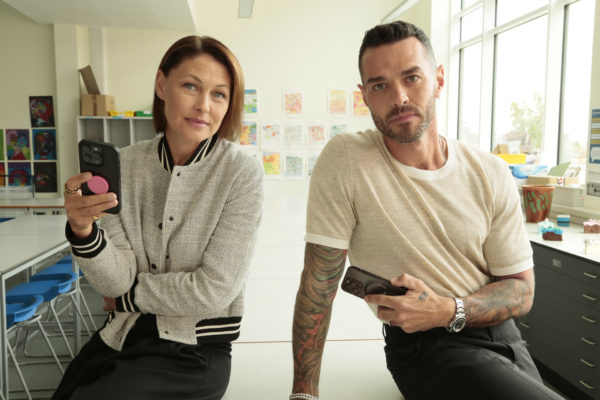Meet The Parents Fighting For Smartphone Free Childhoods
By
2 months ago
Dreaming of a future where technology serves the people

Are we dooming our children to lives dictated by phone addiction? Not if these parents have anything to do with it. Daisy Greenwell started the Smartphone Free Childhood campaign in February 2024, and within a day it had gone viral, reflecting the mass fears parents have about giving smartphones to their children. So, smartphones: necessary evil, or something that can be managed? With the help of new technologies, schools, and local WhatsApp groups, it sounds increasingly like the latter.
Inside The Smartphone Free Childhood Campaign
Although he is speaking in an upbeat tone to a sunny crowd of Californians, Dino Ambrosi is presenting something much gloomier: the average US teen – should they live to 90 – will spend 93 percent of their remaining free time staring at a screen. Dino, who founded Project Reboot (which helps teens build healthier tech habits) is giving a TedX talk titled The Battle For Your Time, and laying out the stark reality of our relationship to digital devices – should we continue as we are.
‘I remember when smartphones first came out,’ says Daisy Greenwell, ‘I was about 25. My friend Nick was the first in our group to get one. In the pub one day, we noticed he’d just disappeared into it. And one by one we all succumbed.’
A quarter of all British children receive their first smartphone aged five to seven years old
The chances are that your screentime is scarily high – translating to weeks-each-year high. According to the Opal Screen Time Report 2023, the average adult in the UK spends five hours outside of work looking at a screen, well on their way to Dino’s 93 percent. The effects of this are miserable, and quite literally so: one study found that people who spent more than 6 hours a day on screens had a higher odds ratio of developing moderate or severe depression. Still, the chances are that you also recall a time before the ubiquity of smartphones. This allows you, when confronted with the facts, to re-evaluate the relationship to the supercomputer in your pocket. The issue? The next generation won’t.

Kids can’t pull themselves from their phones like adults can, as their prefrontal cortexes aren’t yet developed © Getty
‘If an adult disappears into their phone, that’s ultimately fine,’ says Greenwell. ‘But with a child? Their prefrontal cortex isn’t developed. They’re less able to pull themselves out of it; the impulse control isn’t there.’ While in Australia a landmark bill has just passed, banning social media for all under-16s, in the UK parents complain that there’s no guidance on when or how to allow children social media or smartphone access. We’re woefully behind. A quarter of all British children receive their first smartphone aged five to seven years old, and among this cohort, a third are on social media platforms (despite minimum age guidance).
It was this context that led Greenwell to start the Smartphone Free Childhood campaign in February 2024. What started as a WhatsApp channel between friends – ‘my daughter was eight and had realised people were getting phones in her class’ – contained 2,000 families within 48 hours. The campaign’s mission critical is to encourage parents to band together, in conjunction with schools, to delay smartphones for their children until the age of 14.
‘The internet is not a safe place for children,’ says Greenwell, ‘it’s commonplace for children to see lots that we’d never show them in real life: disgusting porn videos; violent beheadings; anorexia content; self-harm.’
This is not helicopter parent worries. Global research firm The Harris Poll estimates that 41 percent of children have been exposed to mature content after receiving a smartphone; just under half of parents surveyed wish they’d gotten their child a phone slightly later in life.
Therapist Chloe Billington points out the very real dangers of smartphones to a young mind. ‘Evidence strongly indicates that the surge in anxiety among teens since 2010 – and depression to a lesser extent – is directly related to smartphone use,’ she says, ‘There is also now a sizeable link being made between heavy social media use and mental illness in girls specifically.’ ‘And beyond that,’ says Greenwell, ‘it’s about the addictive nature of the device.’
There is still some debate about whether smartphones are inherently addictive. The definition of addiction is spurious and for phone-addiction to qualify it would need to offer some social harm. But one recent review of the literature suggests that by any definition 25 percent of the global population might be considered addicted in some way to their smartphone. And the technology seems designed to capture and keep us there. Short-form video and infinite scroll, posited the penitent engineer who invented the latter, tickles the same part of our brain that is tantalised by slot machines. We keep on swiping, anticipating that we’re always on the cusp of a motherload of dopamine.
‘Every parent feels they’re in this impossible position,’ says Greenwell, ‘desperately not wanting to give their child a phone, but feeling there’s no other choice, their child is saying, “I’m miserable, I’m the only one without one.’’’
This, suggests Greenwell, is where schools may play a unique role. ‘Teachers have an outsize influence on their parent community in terms of what the social norms are,’ she says. ‘To come out and say ‘we don’t think your child needs a smartphone’ gives parents the cover they need to resist the upwards pressure from their child.’

Will Orr-Ewing
Will Orr-Ewing’s role in the campaign is to ‘give a voice to how this issue intersects with schools’. A tutor by day (at Keystone Tutors, which he founded), he has seen the impact of phones on learning firsthand. ‘Phones have been in kids’ hands for around 12 years, and most school policies around their usage have been historically flimsy,’ he says, ‘that phones should not be seen or heard within the classroom.’
He says this does not go far enough: ‘these machines have never been more captivating. The average child gets 235 notifications a day. When you’ve got this thing vibrating or pinging in your pocket during class, it’s basically impossible for a child and their daily thinking not to get hijacked by it. That’s the main way I think that it intersects with schools.’
Indeed, studies show that even having a smartphone near a learner impacts their studies. A PLOS One study of 119 undergraduates (who might be supposed to have a little more self-control than, say, the quarter of 5-7 year olds with phones) found that as little as a 3-second distraction knocked cognitive processes off-track. Wider empirical evidence even goes so far as to suggest that thinking about your smartphone has a significant negative relationship with memory recall. Seen-and-not-heard policies may not be enough, then.
Orr-Ewing says he’s a longtime admirer of the Heritage School in Cambridge. This school is thought to be the country’s only screen-free school – the school’s own marketing claims children recite poetry and never learn from powerpoints or iPads. Many schools, if not going to such lengths, are establishing stricter smartphone boundaries. St Swithun’s this September became a smartphone-free environment for its year seven to 11-year-old girls (‘Research shows direct links of phone use and phone addiction to poor mental health and low self-esteem – and also time on smartphones is time not spent with peers,’ said headmistress Jane Gandee). Eton now provides a school-issued Nokia brick to all new boarders. Belhaven School completely bans mobiles but permits managed iPads (Head Olly Langton: ‘Smartphones are designed to be addictive. They’re a distraction.’). And Brighton College’s headmaster was crying out for a schools’ ban as early as 2018 .
Schools are perhaps the battleground most vital to getting the UK’s children away from smartphones. But not alone, cautions Greenwell.
‘The clear problem here is that tech companies keep telling us that it’s a question of an individual choice: everyone can do what they want,’ she says. ‘But no one at all feels they have a choice. We need a societal solution.’
‘We can’t be naive about it,’ agrees Orr-Ewing. ‘If you see tech companies’ reaction to The Anxious Generation by Jonathan Haidt, they began focusing on and funding research which demonstrates that correlation doesn’t equal causation – stating that just because all of these negative things [like phone addiction] are happening after people started using smartphones doesn’t mean it’s causing it.
‘They’re funding a lot of academics, a lot of public affairs research around the question. Their commercial interests are at stake. I think Meta makes 25 percent of its profits from children.’
This claim is hard to verify; when contacting Meta for this article, it contests that it does not break down its public earnings by demographic. But a study by Harvard in 2023 does show evidence that social media companies in combination made $11 billion in revenue from advertising targeting children. And the funding bias is a real phenomenon: when scientific studies have a financial sponsor, the results tend to lean in the favour of the sponsor’s interests. This has been observed in studies funded by tobacco and pharmaceutical companies.
Though Big Tech has brought us to this place, it may offer some solution. Smart-ish phones – or ‘dumbphones’, as they’ve been monikered – which still have WhatsApp, music and maps, but that’s about the sum of it. The options on the market are currently limited. Pinwheel, a US product recently launched in the UK, is a smartphone designed for kids that allows parents to gradually increase the range of apps accessible on the device. But more excitingly, suggests Orr-Ewing, this offers a market opportunity. ‘A lot of phone manufacturers don’t currently receive much revenue from a child having a phone,’ he says, ‘as most first phones are hand-me-downs. We could create a market for starter phones, bring in the tech and telecoms companies in that space, like the BBC and BT.’
‘And we’re working with Nokia HMD on the Better Phone Project, to co-create the ideal phone for kids,’ says Greenwell, ‘and then Xplora, who make smartwatches, to launch their first smartphone this year.’
The other part of the solution is the law. ‘Parents feel totally lost without guidance from any official body about what age to get your child, how young is too young,’ says Greenwell.
The UK government is toying with one bill, but ‘we were disappointed on the last hearing,’ says Orr-Ewing, ‘as our part of the bill was dropped, where we were trying to legislate to make schools completely smartphone free.’ The Safer Phone Bill is on its second reading and has cross party support. Its three main prongs are: to raise the age of internet adulthood from 13 to 16, so companies cannot harvest data from children; provide headteachers the legal footing to ban phone usage within school hours; and provide Ofcom the power to punish those exposing children to ‘addictive by design’ applications.
Despite their part in the bill being dropped, campaigners still back it more broadly. ‘I really hope that it will make this discussion more of a mainstream issue,’ says Orr-Ewing.
But they urge it to be swift. ‘AI is going to supercharge all of this,’ warns Greenwell, ‘so we’ve this last chance saloon to get some people-power structures in place to prevent the issue escalating. This is fixable. It’s going to require unified efforts between parents and schools and teachers. If everyone recognises the problems of phone addiction, and we link arms, we can sort it: the children happier, the parents happier, the schools happier. It’s people-power in action.’






